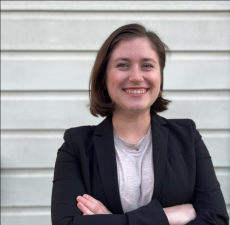The purpose of our first visit to Kulu Opal Primary School was to meet with the Head Teacher (equivalent of a Principal in the United States) and discuss his role in the project. The Head Teacher is the primary contact for the project and responsible for overseeing its implementation on a daily basis. Mary, Emma, Walter, and I drove down a dusty and divot-ridden road for an hour to reach Kulu Opal – certainly the most remote place I have yet to visit in Uganda.
The Head Teacher is named Layroo Gioffrey* and is a smart, motivated man. He quickly assumed the responsibilities of mobilizing the parents, Parent Teacher Association (PTA), and School Management Committee (SMC) (equivalent to the Board of Education in the United States) and overseeing the project implementation on site. He has warmly welcomed us to his school and is kind enough to offer us lunch (chicken, posho, and beans) when we visit!
After speaking in the Head Teacher’s office, we toured the existing latrines. The school currently has 4 sets of 5 stances – 2 sets for boys and 2 sets for girls. However, one of each sets of stances are non-operational.
The District Education Office set a standard of at least 1 latrine for every 40 students. Unfortunately, Kulu Opal does not meet that mark, with only 1 latrine for every 80 boys and 1 for every 72 girls. Even the stances that are “operational” are not in good condition.
The stances do not have working doors. There were huge spiderwebs in the corner of the latrines, swarms of flies above the latrine holes, with old feces smudged on the floors and walls. The flies are of high concern, given the high malaria risk in northern Uganda. Click here to view a video made by GDPU and the Advocacy Project that shows the status of the toilets in Kulu Opal in 2023.

“Operational” girls toilets at Kulu Opal, with standing liquid at the entryway (it had not rained that day)
The Head Teacher told us that this WASH project is desperately needed at Kulu Opal, and in seeing the status of these toilets, I am assured it is true.
—
*In Uganda people say their surname/last name first and then their first name second. It is a little confusing, but it also makes a lot of sense when we consider alphabetizing lists and grouping individuals by family.
Posted By Julia Davatzes
Posted Jun 25th, 2024






3 Comments
Mary Ellen Cain
July 1, 2024
It’s true that funding for these schools is limited, but something as basic as good, clean latrines has such a positive impact on the students and the quality of their education. Kudos to Emma and her colleagues who have a big job keeping the educators, parents and students motivated to maintain these latrines. I look forward to seeing more reports on this project.
Iain Guest
July 3, 2024
Nice to see you back at Kulu Opal school! We were impressed by the staff and students when we visited last summer, but the toilets were in dreadful condition! One thing for you to consider: some of the KO toilets date back to 1995 if I’m not mistaken and were installed by Japanese aid. We heard repeatedly that donors NEVER return to check on their toilets – presumably if they did they would not like what they find! But also, it underscores the importance of follow up and monitoring. I know that’s a key part of your summer work plan, Julia, and hope to see a blog or two in due course. Second, your reference to malaria – yes, it’s so bad that the kids even sing of it (watch our video!) If GDPU can integrate that into the model it would be cool, tho we must be careful not to impose our own views and aspirations… Third, Save The Children just installed new classrooms at KO school. Might be worth a visit to STC, to see if there’s any possibilities for future collaboration. Keep up the great work!
Bobbi Fitzsimmons
July 6, 2024
Your photos are certainly worth many words. With the heat, the insects, and the unsanitary conditions of the current stances, it is no wonder young girls stay away during their periods. We all hope that this installation will make a difference to these students.